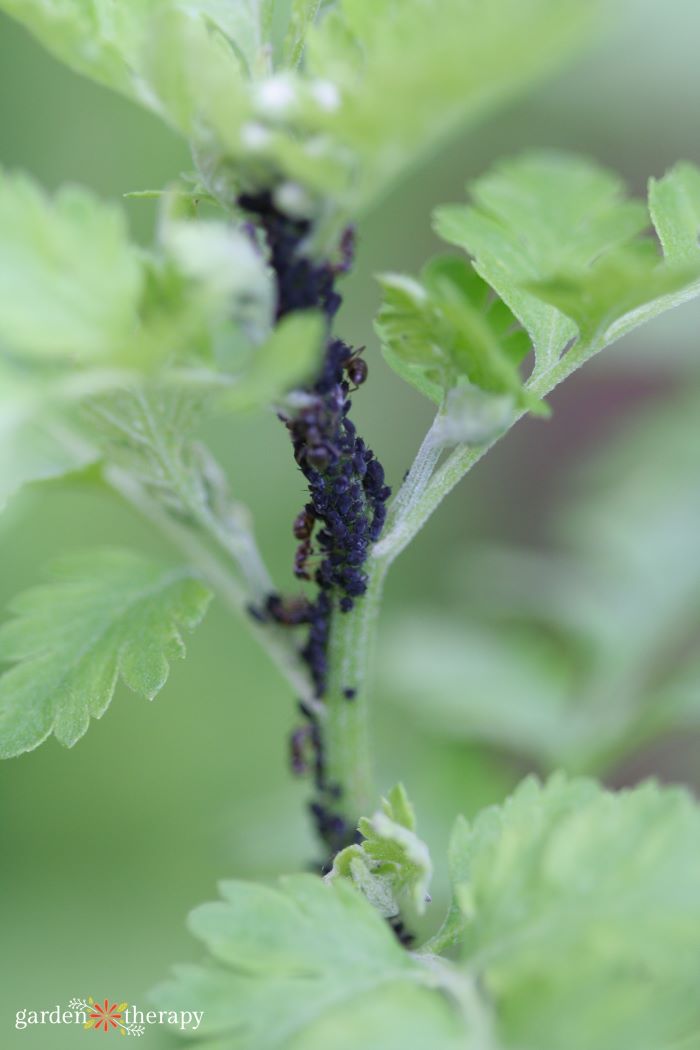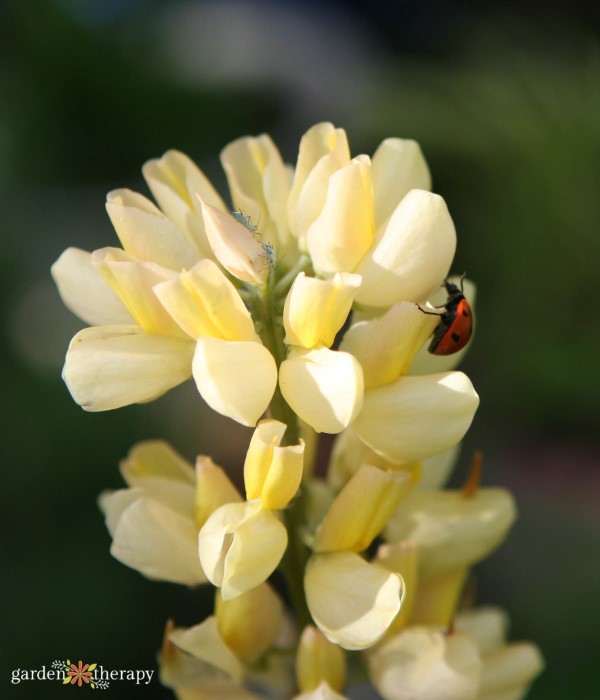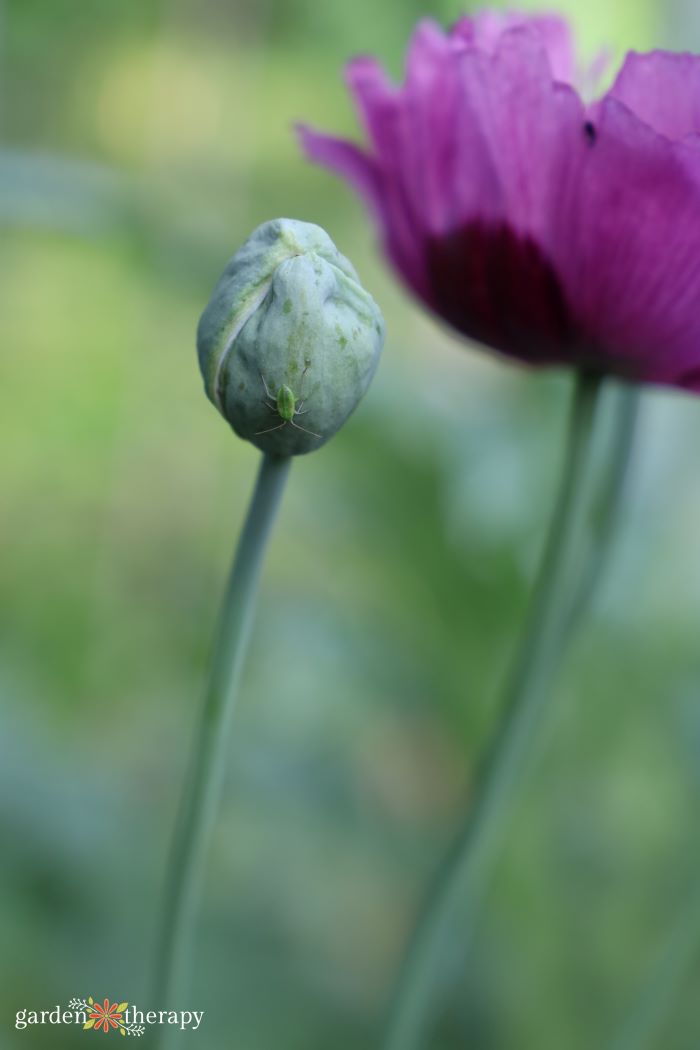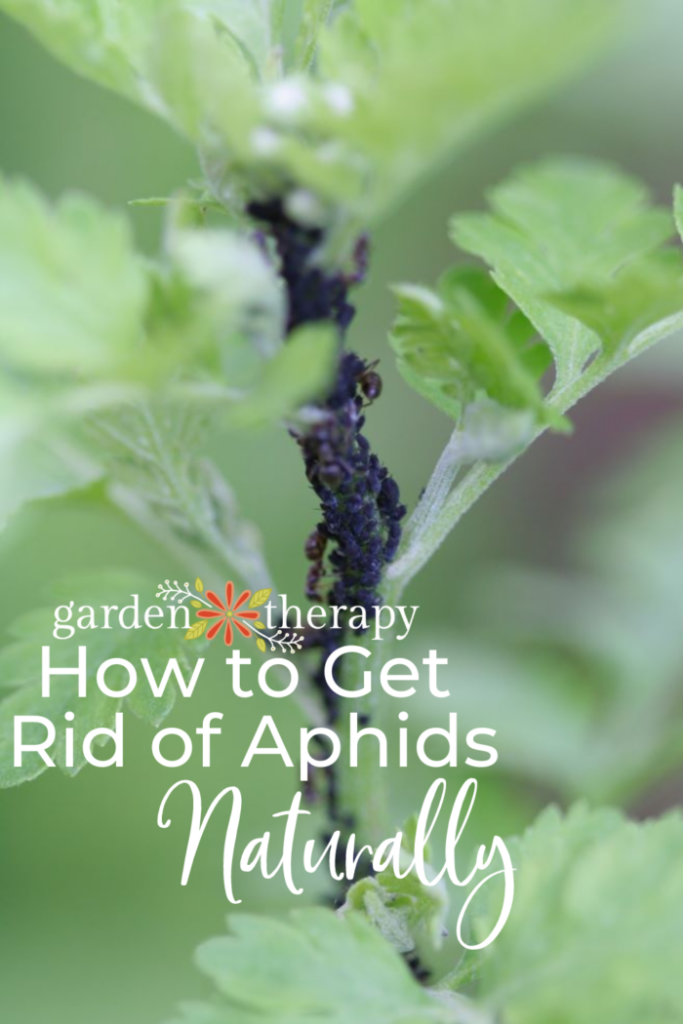Tiny but ferocious, aphids in the garden can suck precious juices from some of our favourite plants. The good news is they make great food for some good bugs and can easily be controlled! Get rid of aphids from your garden by trying some of these natural methods.

Get to Know the Aphid
Aphid Appearance
Small little guys, aphids are 4-8 mm in length. They have pear-like bodies that are soft and easily squished. They come in green, black, red, or white.
You may also see a woolly aphid. Though their bodies are green or blue, they appear fuzzy due to a waxy coating on their body. Their appearance almost resembles a tiny fluff of cotton.
Aphids can be either winged or wingless, depending on the type of aphid and the point of their lifecycle.
Aphid Lifecycle
In one year, the aphid goes through many phases of life. Beginning in the spring, a crew of all-females hatch from eggs sitting during the winter. An aphid will live anywhere from 1 to 6 weeks.
All spring and summer aphids produce asexually, meaning they are clones of their mother. This generation is born to live rather than produce eggs. Some will grow wings and leave their host area.
By the time fall rolls around, there will be some male aphids and they will mate. The females lay the eggs for the winter, and then the cycle repeats.
Females can produce up to 12 young a day, resulting in around 80 eggs in their lifetime.
Where do Aphids Come From?
Since they love new growth, aphids are one of the first pests to appear in the season. They live on or nearby plants they like to eat. Coniferous and deciduous trees are some of their favourites.
Aphids may also sneak their way into the garden via nursery plants. Whenever you purchase a new plant, thoroughly inspect it for any unwanted travellers before purchasing.
Aphid Damage
Chances are you’ve had some aphid trouble in your garden. They love to munch on organic vegetables, sometimes ruining a harvest you’ve spent a summer growing. While I’m a bug lover, I don’t like it when aphids destroy my vegetables. I try to grow more food than I need just so wildlife can enjoy some too. But even I must draw the line sometimes!
Aphids feed on plant sap, especially drawn to any new plant growth though they will feed anywhere. They produce a sticky substance called honeydew as they eat that can attract other insects such as ants. Honeydew can also cause fungal growth in a plant.
They arguably cause the most damage to home gardens than any other insect. Feeding in large groups, a severe infestation can quickly cause lots of damage. An infested plant may have stunted growth, a low yield, and can even die.
A damaged plant may have spots, yellow colouring, curling leaves, and may wilt. Galls can also form on the stems and branches of the plant. To spot aphids, look under leaves, on new branch tips, and any new growth. You may also spot their shed skin under the plants, appearing like white flakes.

Root Aphids
Sugarbeet root aphids are a cousin to the common ones found in the garden. However, they stay at or just above the soil line.
This type of aphid can quickly get out of control. They form galls on the plants and are especially drawn to narrowleaf cottonwood trees.
Aphids on Roses
You may have spotted some buggers on your roses. Typically, these are rose or potato aphids. To get them off your roses, try to wash them off with water every day for a few days.
Aphids also like nitrogen, so only use slow-release fertilizer on the rose bush. This way, they won’t have a sudden rush of nitrogen for the pests to feed on.
Aphids on Tomatoes
Potato or green peach aphids can be found on tomato plants. Surprisingly, tomatoes can handle a fair number of pests. But like any plant, a large infestation may affect how many tomatoes the plant produces and can also cause stunting.
Aphids on Milkweed
Because milkweed is the only host plant that monarch caterpillars eat, you want to keep aphids away from the plant. They can take away all the good nutrients, affecting the food source of the caterpillar.
Never use pesticides on milkweed to get rid of aphids. This could seriously harm the caterpillars and therefore, the monarch population.
Most often, the oleander aphid eats milkweed. They are a bright yellow aphid with black legs.
How to Get Rid of Aphids Naturally
You may be looking to kill aphids, but I strongly urge against reaching for the harsh pesticides right away. I never kill pests as I believe that every insect belongs for a reason, even the pesky aphids! As a major food source for all kinds of insects, eliminating them can negatively affect the ecosystem of a garden.
That being said, I do like to keep them away from my favourite plants and use all of the methods below to control aphids in my garden.

Invite Predators
While aphids may not be friendly, there are so many beneficial insects you want to have in your garden. The best way to keep aphids at bay is by inviting their arch-nemesis into the garden…ladybugs! Ladybugs, one of my favourite beneficial bugs, are the most well-known aphid predators.
A gorgeous red with adorable polka dots, you can enjoy their beauty and watch as they munch away on aphids. In fact, a single ladybug can eat up to 5,000 aphids in its lifetime. Now we’re talking! They also enjoy eating mealybugs, mites, scale, and more annoying pests.
A few other bugs eat aphids. Green lacewing larvae like to chomp on them while they grow into an adult. Hoverfly females also lay eggs in patches of aphids so that their larvae can hatch and eat them. Minute pirate bugs are also known to attack and eat infestations of aphids.

Pest Repellent Spray
As an organic gardener, I stay away from all kinds of pesticides. While they can be useful at keeping away pests, they also kill all the good guys too. And we certainly don’t want that!
I have plenty of vegetables and plants I would rather not have certain bugs munching on. I make my own pest repellent spray to keep them away from the plants I care the most about. Using ingredients from my garden that pests naturally hate, the spray is simple to make and costs pennies. In fact, many of the commercial products also use some of the same plants in their ingredient list (and a few additives I don’t like).
This natural spray keeps things as close to nature as possible, keeping pests away without disrupting the ecosystem of my garden. For the full recipe and list of herbs to include, read my blog about making natural pest control spray.

Companion Planting
Companion planting has all sorts of amazing benefits, one of them helping to ward off insects. Chemical-free and completely natural, the best part about companion planting is the reason to buy more plants!
Strategically interplant herbs and vegetables that aphids don’t like next to your plants you want to keep them away from. This means tucking a few of the plants listed below between your vegetables and flowers.
Try growing some of these plants for aphid control:
- Alliums (chives and onion)s. They also ward off spider mites and carrot fly. Ladybugs also enjoy them!
- Catnip. Beware, cats do love it so you may have some feline visitors.
- Cilantro. Another ladybug favourite and aphid deterrent.
- Dill. Ladybugs love this one too.
- Garlic. A deterrent for all sorts of pests, keep away aphids, spider mites, ants, snails, Japanese beetles, and more.
- Mint. Like many on this list, you can not only enjoy the mint in your vegetable garden but use it to deter pests.
Attract Aphids
I know what you’re thinking: I’m trying to get rid of aphids. Why on earth would I try and attract them to my garden?
Hear me out! You can strategically attract small infestations of aphids on hardier plants to bring all sorts of good predators to the garden. If I allow them to live in one corner of my garden on some of my established trees, some ladybugs may stop and pay a visit, protecting the whole garden.
Ladybugs lay their eggs in aphid-heavy areas so that when their young hatch, they have a food source. No aphids mean no ladybugs.
Nasturtiums are a trap plant for aphids. They will attract them, encourage ladybugs to stop and pay a visit, and keep them away from my vegetables. In addition to nasturtiums, I also grow Shasta daisies for black aphids and lupines for green aphids.
Which of these aphid control methods will you be trying? Let me know in the comments down below!






Excellent advice. Thank you!
Greetings,
I have a serious aphid problem. I planted a group of milkweed to help out the monarchs. They’re covered with aphids now. I purchased a little tub of ladybugs and also heard that praying mantis eat aphids. What I didn’t now until after I released the ladybugs, is that they also will eat the monarch eggs! I was lucky that the mantis egg hadn’t hatched so I removed that immediately.
I have planted merigolds around the group of milkweed and also sprinkled coffee grounds around since I read somewhere they don’t it but I can’t seem to get rid of the problem! Only a few ladybugs hung around and are doing their part but it’s really depressing and overwhelming. I have seen some monarchs dancing around the plants trying to find a place to lay it’s egg. I don’t know if it bothered to. Your thoughts would be appreciated.